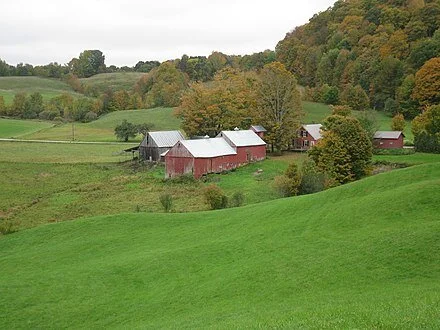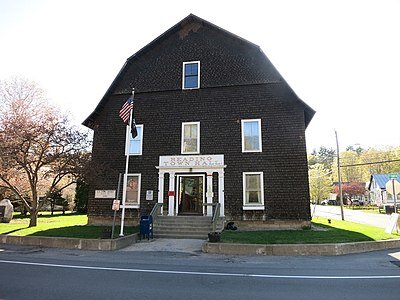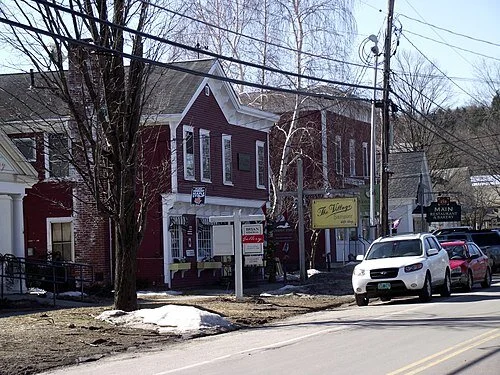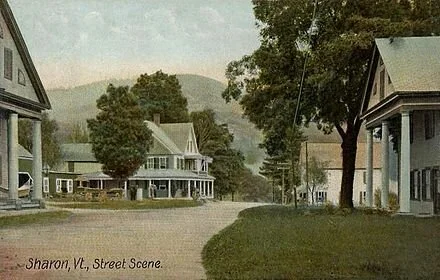
'Lonely, happy child'
Newly emerged adult cicada
— Photo by Ollllonate
“Parents open their shutters and call
the lonely, happy child home.
The child who hates silences talks and talks
of cicadas and the manes of horses.’’
— From “All Summer Long,’’ by Carol Frost (born 1948) in Lowell, Mass. She has taught at the Vermont Studio Center, in Johnson, Vt.
‘Adding and subtracting layers’
“Railroad Ties” (oil and cold wax on panel), by Helen Shulman, at Edgewater Gallery, Middlebury, Vt.
The gallery says:
“Helen Shulman’s abstract, mixed-media paintings draw on her interest in the manipulation of surface texture, color, and mark making, and are compositions that may have their origins in the landscape or the figure but become about the process of adding and subtracting layers, creating texture, and interest that will draw the viewer in and through each piece.’’
Dynamic wooden shapes
“Plaid Flannel” (carved polychromed sugar maple), by Vermont artist Clark Derbes, in his show “Time Travelers and Portals,’’ at the Hall Art Foundation, Reading, Vt., Aug. 28-Nov. 28.
The show’s organizers say: “Derbes first cuts blocks of wood from a variety of tree species, including elm, poplar and maple. Continuing to carve each block into a unique and dynamic shape, he meticulously chisels, paints, sands and burnishes each piece in order to achieve a variety of complex geometric visual systems, planes, patterns and patinas.”
The much-photographed Jenne Farm, in Reading
Reading Town Hall and post office.
Look at when temps exceed 90
“Rapture’’ (oil), by Stephanie Bush, in the show “Made in Vermont,’’ at the Bryan Memorial Gallery, in Jefferson, Vt., through Sept. 6.
The show’s organizers say it “showcases the ingenuity and resourcefulness of Vermonters’’ and centers “around Vermont’s diverse landscape of farms, growing cities, breweries, industry, old and new infrastructure and more.’’
In downtown Jeffersonville’s (pop. about 800) Historic District
Those boots are history
“Vern has gone up to the attic to hunt for a fish pole and I trailed along after him. The attic was just like that of any other North Country farmhouse – cobwebby corn, and old clothes; corners piled full of haircloth trunks, boxes, and dead furniture. I saw a homemade cradle, an ancient spinning wheel, a flax-carder, piles of books and magazines and then, suspended from a nail, two pairs of rivermen’s boots….Vern took them in one huge hand and held them almost tenderly. ‘These boots, young feller,’ he said to me, ‘may be said to mark the passing of an era.’’’
From Spiked Boots: From New England’s North Country, True Stories of Yesteryear, When Men Were Rugged and Rivers Wild, by Robert Pike (1905-1997), a scholar and writer who grew up in Waterford, Vt., on the Connecticut River.
Looking across the Moore Reservoir at Waterford, Vt.
Writing on the trail
View of Mt. Mansfield on Vermont’s Long Trail
The Ompompanoosuc River, a tributary of the Connecticut River. Its headwaters are in Vershire, on the eastern side of the Green Mountains.
“In high school, I went to a place called the Mountain School. It's on a farm in {Vershire} Vermont, and I read Emerson and Thoreau and ran around the woods. Now I go hiking with a bunch of my comedy buddies. We talk about our emotions. I also do a lot of writing on hikes, just to get the blood flowing and the ideas moving.’’
Nick Kroll (born 1978), American actor, comedian, writer, and producer.
Vershire was named "Ely" in 1880, after the Ely Mining Company, which mined copper. This changed in 1883, after 200 miners struck and seized the mine, leading the National Guard to be called out to suppress the miners. You don’t think of New England having such mines, but there were a bunch of them in northern New England, in the 19th Century.
Proper places for gossip
Dan & Whit’s general store, in Norwich. Vt. It’s one of the rural area’s best known meeting places.
“I see no truth at all in the myth that rural New Englanders are taciturn — they love gossip as well as anyone I ever knew — the talk takes place mostly on neutral ground: in stores and barnyards, at auctions and church suppers. Your home is private”
— From The Amateur Sugar Maker (1973), by Noel Perrin
Small town 'third places'
Post card from 1906 of Sharon street scene
From Robert Whitcomb’s “Digital Diary’’ in GoLocal24.com
I got a pang when reading in The Valley News that another small-town local store that has acted as an informal community center is being absorbed by a chain. This is the Sharon (Vt.) Trading Post, a general store and gas station. It’s been owned for 32 years by a local couple – Rob and Cathy Romeo -- but they’re selling it to a chain of 50 convenience stores/gas stations, albeit a Vermont one, called Maplefields. Maybe that means prices will fall a bit – economies of scale – but so probably will service and commitment to the community, in the White River Valley, for which the store has been a central meeting place.
There are fewer independent establishments in small towns like the Romeos’ these days, and that’s too bad. All towns need “third places’’ – not work, not homes – to get together.
To read more, please hit this link.
Green Mountain gorgeous
"Top of the World" (pastel), by Ann Coleman, in the Ann Coleman Gallery, West Dover, Vt., part of Dover, in southern Vermont, and best know for Mount Snow, the big ski area that was among the first to install snow-making equipment and that has always had a large percentage of “snow bunnies,’’ who tend to lounge at the base lodge rather than ski.
An edited version of the Wikipedia entry on Dover:
“West Dover was settled in 1796, when the area was part of Wardsboro, and was incorporated into Dover when that town was chartered, in 1810. The village grew economically in the 19th Century due to the construction of mills along the river. The first mill, a sawmill, was built in 1796, and was expanded to process wool through the first half of the 19th Century. The mill complex was destroyed by fire in 1901, bringing an end to that source of economic activity. Only traces of the mill complex survive today, but the village has a fine assortment of Federal and Greek Revival buildings that give it its character. In the 20th Century the village benefitted from the state's promotion of out-of-staters’ purchase of farms for vacation and weekend homes, and the growth of the nearby ski areas.’’
Will Amazon spawn old-fashioned Main Street retailing?
"View of Manchester, Vermont, '' by DeWitt Clinton Boutelle (1870)
From Robert Whitcomb's "Digital Diary,'' in GoLocal24.com:
What will become of cities as more and more work is done on the Internet and more and more stuffis delivered by mail (and drones?). At first glance you might think that these changes will hollow out the cities.
But people seek respite from screens and, for that matter, much paid work will continue to be done off screen. Consider that big growth areas for future jobs include such trades as electricians, plumbers, roofers, linemen, etc.
Seeing people in the flesh, not just virtually, will become more attractive as we become sated with screen life. Indeed, it’s essential for good health. And important decisions will continue to be best completed, and new ideas most cogently expressed, in real encounters. That’s one reason that Manhattan still thrives, in spite of its high costs. You can’t do a merger deal online. You have to meet in person.
Young adults, especially those with children, will continue to move to, or stay in, the suburbs, but future suburbs will look different from ‘50s- and ‘60s-style subdivisions. For one thing, they will have dense, very walkable centers for shopping, distribution and entertainment, and, especially, meeting people, with many smaller specialty stores in place of the vast malls and even vaster windswept parking lots around them. There will be fewer ugly big-box stores because so much of their brand-name stuff will be shipped directly to customers via Amazon, etc.
Highly specialized stores, many with unique items – some of them locally made ---can do well in these suburbs-becoming-mini-cities within broader metro areas. They’ll be staffed by salespeoplevery knowledgeable about their products and services and with long-term relationships with customers.
The Boston Globe reports: “Credit Suisse has predicted that upwards of a quarter of the 1,200 malls in America will close in the next five years.’’
“Today, if you know what you need, you go to Amazon and buy it,’’ Pam Danziger, president of the Pennsylvania-based Unity Marketing, told The Globe. “Where you’re going to find interest is on Main Street and not in these homogeneous same-old, same-old outlet stores. Main Street — where people really know you — that’s where the future of retail is.’’
Read the highly instructive case of toney Manchester, Vt., suffering from the decline in shopping at its many national chain outlets and so now looking to go more local. Please hit this link:
https://www.bostonglobe.com/metro/2017/09/15/there-app-for-this-retail-town-suffers-age-commerce/uArZDDp6UX5lzQlB0nsciP/story.html
Meanwhile, the car culture, even in the suburbs, will probably continue to fade with further proliferation of such ride-sharing services as Lyft and Uber and the expansion and diversification of mass transit associated with our aging population and environmental concerns.
Some suburbs are starting to look like center cities. Consider Tysons Corner, in suburban Fairfax County, Va., outside of Washington. Tysons looms like a mini-Manhattan, with office and residential towers. And then there are the small old cities within broader metro areas, of which there are many in New England – think Concord, N.H. and Portland, Maine. I think that they’ll grow as people seek the conveniences of more than traditional suburban density but without the costs of living in such big cities as Boston and New York, whose centers are increasingly for the rich.
Relatively new suburban places such as Tysons are called“edge cities’’ . But we’ve got what are small old “edge cities’’ around here, such as Pawtucket, R.I., which might have the urban bones to become more lively and prosperous.
Then there are the mid-size cities, such as Providence, Worcester and New Haven. They’ll draw people with their commercial and cultural attractions but won’t have the critical mass to become big cities. Rather, they’ll be ancillaries that will perform some of the services provided in nearby big cities -- e.g., Boston and New York. They’ll continue to lure folks who want to live in real cities but want/need somewhat less density and considerably lower costs than in Boston and New York.
Even Hartford, now an urban disaster area, ought to be able to eventually turn itself around and market its assets (especially its riverfront) as well as, say, Providence has done with its advantages.
Then there will be new mini-metro areas far away from big cities. One is the Lebanon, N.H.-Hanover, N.H.-White River Junction in the Upper Connecticut River Valley. There, the intersection of two major Interstate highways – Routes 89 and 91 -- along with the presence of a well-known university (Dartmouth College) and associated large medical center has for several decades been creating a kind of city – still sprawling but gradually being pulled together by, among other things, public transportation (encouraged by the proliferation of facilities, many of them high-end, for the elderly in areas with major colleges and medical centers).
New England, with its many still well functioning towns and small cities with an almost European settlement pattern, would seem well placed to benefit from the technological and behavioral changes roiling the country, the sprawling , utterly car-dependent metro areas of much of the Sunbelt and Middle West less so. People will continue to seek community. At leastin New England that will be easier to find and/or rebuild than in most of the country.

















